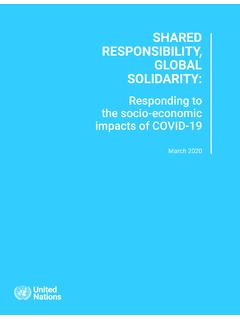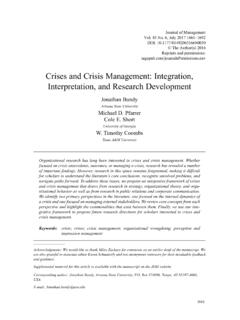Transcription of THE MALAYSIAN FINANCIAL CRISIS: ECONOMIC IMPACT …
1 PThe Developing Economies, XXXVII-4 (December 1999): 417 38 THE MALAYSIAN FINANCIAL crisis : ECONOMICIMPACT AND RECOVERY PROSPECTSMOHAMED ARIFFSYARISA YANTI ABUBAKARI. INTRODUCTIONRIOR to the crisis , Malaysia had been dubbed as one of the miracle economiesin East Asia owing to its maintenance of high growth rates averaging cent during the period 1988 96 in addition to low inflation rate of about3 4 per cent per year. Moreover, the increasing emphasis on manufacturing, andelectronics in particular, ensured high employment rates for the July 1997 however, Malaysia began attracting more international attentionnot for its extraordinary ECONOMIC performance, but for its entanglement in a majorregional ECONOMIC crisis . At the outset, for the more pessimistic observers it wasalready doubtful whether Malaysia s target to become a developed country by theyear 2020 would still be achievable.
2 After all, for the first time in years, the externalvalue of Malaysia s currency, the ringgit, shrank by nearly 50 per cent while thestock market contracted by even more at about 60 per cent. The ringgit fell from anaverage of to the dollar in April 1997 to an all-time low of to the in January 1998. The composite index (CI) of the Kuala Lumpur Stock Ex-change (KLSE) which had been the third largest stock exchange in the region afterTokyo and Hong Kong, fell precipitously from 1, points in June 1997 to on September 1, 1997. Between July 1997 and mid-January 1998, approxi-mately $225 billion of share values were wiped off. Before long, the IMPACT ofthe FINANCIAL crisis was being felt in the real sector as evidenced by business clo-sures, retrenchments leading to high unemployment, and increasing inflation lev-els.
3 For the first time since 1985, the MALAYSIAN economy experienced a recession,contracting by per cent in 1998. By nearly all accounts, the current downturn isworse than that experienced by the country in recession experienced in 1985 lasted for only one year with a mild 10 percent contraction. Two years after the onset of the current crisis , the main problem iswhether a similar recovery is will occur for Malaysia this time, or whether the crisiswill last beyond 1999. Obviously, some positive signs suggest that the worst is overfor the MALAYSIAN economy, although this does not necessarily guarantee that Ma-418 THE DEVELOPING ECONOMIES laysia is out of danger yet. In the past two years the MALAYSIAN government hasresorted to different tactics to withstand the negative effects of the crisis .
4 Whilesome of the strategies employed have been successful, some others have aim of this paper, as the title suggests, is to examine the various impacts ofthe Asian ECONOMIC crisis on the MALAYSIAN economy, to analyze Malaysia s recov-ery prospects in the future, as well as to highlight some of the key challenges facingMalaysia on the road to sustained recovery. The paper begins by describing thegenesis of the FINANCIAL crisis in Malaysia and then proceeds to outline the variouspolicy responses of the MALAYSIAN government. In the subsequent section, a snap-shot of the crisis IMPACT on the economy is provided. Malaysia s prospects forrecovery and the challenges associated with ensuring sustainable future growth aredealt with in the final FINANCIAL crisis IN MALAYSIAIn mid-May 1997, the Thai baht came under severe pressure from speculative at-tacks.
5 The ringgit was also not spared, and came under severe selling Negara Malaysia s (the central bank of Malaysia) immediate response was tointervene in the foreign exchange market to uphold the value of the ringgit. BankNegara valiantly upheld the value of the ringgit for about a week before it finallywas forced to float the ringgit on July 14. By that time, the bank had already lostclose to $ billion in the effort to prop up the ringgit. At its lowest point, theringgit depreciated against the dollar by almost 50 per cent, hitting a high of to the dollar on January 7, 1998. After a brief period of stability duringFebruary and March, the exchange rate continued to deteriorate with wide fluctua-tions in the following more drastic than the plunge in the exchange rate, was the collapse of thestock market.
6 Between July and December 1997, the composite index of the KualaLumpur Stock Exchange (KLSE CI) fell by per cent. Following a slight recov-ery in the first quarter of 1999, the index again fell, this time to an eleven-year lowof points on September 1, 1998. On the whole, between July 1, 1997 andSeptember 1, 1998, market capitalization in the KLSE fell by about 76 per cent toRM billion. In fact, although it enjoyed the best precrisis ECONOMIC funda-mentals among countries that were hit by the crisis , Malaysia experienced the big-gest stock market plunge in the property bubble also subsequently burst, and the crash was accompanied by1 The exchange rate value of the ringgit continued to fluctuate in the following months until it wasfixed at the rate of RM to the dollar in September was no improvement in stock prices until the newly introduced selective capital controlsbrought about some relief in October capital outflows as confidence in the MALAYSIAN economy became increas-ingly shaky.
7 As a result, the banking system began to experience increasing non-performing loans (NPLs) which, according to Bank Negara data, rose from about amodest per cent in June 1997 to per cent in December 1997, and then toa high of per cent in July 1998 (Malaysia, EPU 1999). Private sector esti-mates for NPL ratios at the time were much higher than the official figures sug-gested, as many companies had begun to roll over debt as part of their survivalstrategy. Meanwhile, the increase in NPLs in the banking and FINANCIAL sector wasreflected in a sharp downturn in borrowing and financing, bringing about tight li-quidity a short time lag, the real sector of the economy also began to feel thenegative effects of the crisis . Weak stock prices, the property market slump, and thenet contractionary IMPACT of the ringgit depreciation together led to a negative wealtheffect which resulted in a general contraction in domestic demand.
8 Consequently,domestic-oriented industries, such as the construction and services sectors, wereseverely hit. Meanwhile, private investment generally contracted due to the uncer-tainties arising from volatile exchange rates, the decline in local and external de-mand, as well as excess capacity and tight liquidity position in the economy. For-eign direct investment (FDI) levels, as measured by the value of applications re-ceived in the manufacturing sector and applications for investment incentives fromthe hotel, tourism, and agriculture sectors by the MALAYSIAN Industrial Authority(MIDA), displayed a declining trend over the period January December the public sector, a decrease in both expenditure and investment was initiallyexpected following the government s announcement that it was slashing the budgetfor operating expenses by 18 per cent, not to mention the cancellation and/or post-ponement of several infrastructure mega-projects.
9 With the slowdown in consump-tion, investment, and government expenditure, the only source of growth was ex-pected to originate from the country s net exports. The initial IMPACT of the crisisled to declining imports of luxury goods as domestic demand slowed due to thedepreciation of the ringgit. Imports in general though, did record an increase ( cent year-on-year in February 1998). The high import content of Malaysianmanufactured exports, especially of capital and intermediate goods, goes a longway in explaining the subsequent rise in imports at the time. Meanwhile, exportsrose as well, especially in the resource-based sector, and displayed a continueduptrend in ringgit terms. However, when converted into dollar terms, most ofthe major export categories displayed a downward developments led to an expectation of lower ECONOMIC growth in 1998and 1999.
10 In October 1997, the government forecasted a growth rate of 7 per centfor 1998, but subsequently adjusted it downward to 4 5 per cent in December 1997,and again to 2 3 per cent in March 1998. However, when the national accountswere revealed, GDP growth reached per cent and per cent for the first two420 THE DEVELOPING ECONOMIES quarters of 1998, respectively. It became certain that the economy would contractin crisis -induced slowdown in ECONOMIC growth has had an inevitable impacton Malaysia s social sphere as well. The contraction in GDP resulted in the retarda-tion of employment growth, and the rise of unemployment and retrenchment lev-els. While employment growth had been growing steadily at and per cent in1996 and 1997, respectively, it contracted by 3 per cent in 1998.






